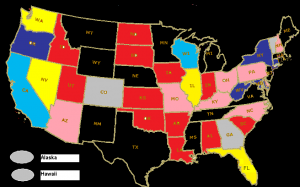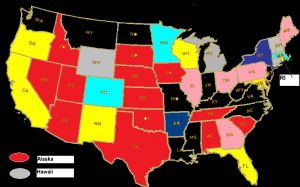Our calls on individual races are based on a composite of polls conducted over the last 28 days (we will compress this “look back period” once primary season has concluded in mid September) using the following criteria:
(1) Safe Democratic (dark blue on the map)/Safe Republican (dark red on the map) – either a candidate leads by 10 or more points, or a candidate has over 50% in polls;
(2) Lean Democratic (light blue on the map)/Lean Republican (light red on the map) – a candidate leads by 3-9 points;
(3) Tossup (yellow) – a candidate leads by less than 3 points;
(4) No data available/primary has not been held (gray) – In general, we don’t analyze statewide polls until its primary has been conducted. However, since pollsters have been releasing multiple polls with different Democratic/Republican matchups for states that have not held their primaries, we will modify this rule as follows: if at least one of the major parties has a clear front runner in a contested primary, we will use the various poll matchups to get a sense of how a Senate/Governor race is leaning and, based on that composite of polls in the last 28 days, will assess which party is ahead.
(5) No Senate/gubernatorial race in 2010 for this state (black);
2010 Election Predictions – Senate Races
(7/22, 7/29, and 8/4 projections: 54 Democrats, 46 Republicans, or Republican gain of +5)
Since our last analysis, we have made some changes. We reclassified the Ohio Senate race (an open Republican seat) from “Tossup” to “Lean Republican”, and we now have poll results for the Arizona Senate race. Though this race is currently “Lean Republican”, it’s worth noting that depending on who gets the Republican nomination on August 24, you either will have a 43-38% Democratic lead if John McCain loses his primary, or a 53-34% Republican lead if John McCain is renominated. Since he has recently been pulling ahead in this race, we will probably be able to move this race to “safe Republican” after the Arizona primary has concluded in three weeks.
It’s also worth noting that three of the tossup seats are held by Democrats. If the Republicans were to sweep those races while defeating the three term Democratic incumbents in California and Wisconsin, the GOP would have a Senate majority.
2010 Election Predictions – Governor’s Races
(8/4 projection: 31 Republicans, 19 Democrats, or Republican gain of +7)
(7/29 projection: 30 Republicans, 20 Democrats, or Republican gain of +6)
(7/22 projection: 29 Republicans, 21 Democrats, or Republican gain of +5)
Since our last analysis, there are two modifications we are making to our predictions. We have reclassified the Florida governor’s race from “Lean Democratic” to “Tossup”, as recent polls show (in this three way race) the Democrat either narrowly ahead 31-27% or behind 31-35%, depending on which Republican gets the nomination. At the present time, the “stronger” Republican leads in the polls, with the primary three weeks away.
We have noted that one of the big unknowns this November is the effect third party candidates will have on the outcome – we’ve already seen these candidacies muddy the waters in Rhode Island, Florida, and Minnesota. We are now adding Colorado to that list: recent plagiarism revelations against the leading Republican candidate have torpedoed his candidacy, and his primary opponent has his own problems, like a recent fine he had to pay due to campaign finance violations over mileage expense reimbursements. As a result, former Republican Congressman Tom Tancredo has announced his intention to run for Governor as a Constitution Party candidate if polls taken after the August 10 Colorado primary show the Democrat in the lead. As a result, what was once a tossup race must now be reclassified to “Lean Democratic”, since the GOP vote has been split in two, enabling the Democrat to lead comfortably in the polls with only 40-45% of the vote.
2010 Election Predictions – Generic Congressional Vote
(8/4 poll composite: 45.2% Republican, 41.7% Democrat – +3.5% Republican)
(7/29 poll composite: 44.9% Republican, 42.2% Democrat – +2.7% Republican)
(7/22 poll composite: 44.5% Republican, 42% Democrat – +2.5% Republican)
Poll numbers continue to show movement towards Republican in overall voter preference. To put the “Generic Congressional Vote” question in perspective, when Republicans retook the House (and Senate) in 1994, the popular vote in the 435 House districts was 52-45% Republican. If we were to split the undecideds equally between both parties, you would have a 52% Republican vote, which equates to a 225 seat Republican majority – a net gain of 46 Republicans, and seven more than needed to regain control of the House. We also believe at this time that the 225 seat figure is a conservative estimate, since it doesn’t consider voter intensity which clearly favors the Republicans right now.
2010 Election Predictions – Individual House Races
(8/4 : 257 Republicans/178 Democrats (Republican gain of +78, 19 Democrats on the “watch list”)
(7/29 : 256 Republicans/179 Democrats(Republican gain of +77, 18 Democrats on the “watch list”)
(7/22 : 258 Republicans/177 Democrats(Republican gain of +79, 17 Democrats on the “watch list”)
One of the things we have repeatedly mentioned in our discussions of the “Obama plunge” and its effect on the fall elections is that actual poll results take precedence over the theoretical criteria used to determine whether a seat is vulnerable. Additional polling has been released this past week that provides more information on several House races. (1) In June, we initially classified the seat of Heath Shuler (D-North Carolina) as being on the “watch list” because of a poll showing him leading 46-34%. A recent poll came out this past week showing that the race has rapidly tightened up since then, as Shuler now only has a 45-44% lead in the polls. This rapid change in the poll numbers suggests that he may very well be vulnerable, but for now, we’re keeping him on the “watch list.”
(2) We received an unexpected addition to the list of vulnerable Democrats: Two term incumbent Betty Sutton (D-Ohio) represents a blue collar union district near Cleveland that gave Barack Obama 57% of the vote. A poll recently released showed her actually trailing a well financed Republican opponent 44-41% – a huge reversal from the 65% victory she received in 2008. Though she voted down the line in favor of Obama’s agenda, the weak poll numbers obviously have had an effect, as she was one of the first Democrats to call for Charlie Rangel’s resignation due to his ethical transgressions.(3) In a “wave election”, the victorious party is able to salvage nearly all of its vulnerable incumbents. We are seeing this happen with two (according to the Washington pundits) vulnerable Republican freshmen. Charles Djou (R-Hawaii) was universally thought to be a (less than) one termer after he won a May special election with 40% against divided opposition. Yet a recent poll shows him leading his Democratic opponent 50-42%. There was also a poll showing Joseph Cao (R-Louisiana) in the lead against his leading (and Washington Democrat endorsed) opponent Cedric Richmond 51-26%. We therefore are moving Rep Djou to “probably safe” and promoting Cao to the “watch list.”
(4) We had earlier classified two term incumbent Phil Hare (D-Illinois) as vulnerable due to an incident where he confronted a constituent and got his license plate number, placing him in the “Congressmen behaving badly” category. A recent poll confirmed our assessment of his vulnerability, with him trailing 32-45% in the polls after being re-elected without opposition in 2008 in a 57% Obama district.
(5) Finally, in New York, two term Democratic incumbent Dan Maffei has been moved to “Safe Democratic” for now, as competing polls released by him and his opponent show him in the lead with 50 or 46% (depending on who you believe), respectively.
While we are following 220 (out of 435) House races in detail, the following pieces of the “big picture” ought to be mentioned: (1) of the 69 Democrats we think are safe right now, only three are safe due to actual polling data – it’s entirely possible that there are vulnerable Democrats we don’t know about yet, (2) the 19 Democrats currently on the “watch list” could easily see their poll numbers head south once voters start paying more attention to the fall elections, with ethics trials, a weak economy, and healthcare reform in the backgorund, (3) of the 78 Democratic vulnerable or open seats we think are pickups, the poll numbers we have on 17 of those races show extremely weak performances by the Democrats – in several cases, we’re seeing them behind their Republican opponents by more than 20 points. If these numbers hold up, you will start to see them being “cut loose” by Washington Democrats in terms of funding and/or organizational support.
John is a political consultant and blogger with JMC Enterprises with expertise in poll sample development and analysis, development of targeted voter files for phone canvassing or mail outs, campaign strategy and demographic consulting, among other things. See his site at WinWithJMC.com for more information.
Advertisement
Advertisement


